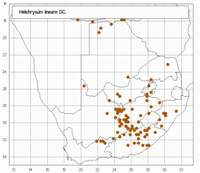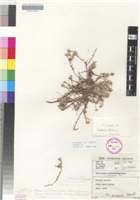Common names:
Geilsiek(te)opslag (A)
Origin of name:
linearis /-e = linear; narrow, with parallel sides
Diagnostic characters:
Prostrate woolly plantVery small compact flower heads
Description:
Perennial herb with a long stout taproot, woody with age, branches up to c. 200 mm long, many spreading from the crown, prostrate or rarely decumbent, simple below, corymbosely branched above especially in old plants, thinly white-woolly, closely leafy. Leaves 5-10 (-13) x 0.75-1 (-4) mm, more or less spreading, linear or lingulate, obtuse, sessile, margins revolute, rarely only weakly so, both surfaces white-woolly, upper often glabrescent, glandular-punctate, viscid. Heads homogamous, cylindric, c. 4 x 2 mm, in small glomerules at the branch tips, closely surrounded by leaves. Involucral bracts in c. 6 series, outermost short, webbed to the surrounding leaves with wool, persistent, inner subequal, erect, tips subacute to obtuse, often erose, usually opaque white, rarely buff or pinkish, shafts pellucid, colourless or reddish, soon caducous. Receptacle conical, tuberculate. Flowers 8-14, yellow, sometimes tipped pink. Achenes not seen, ovaries with myxogenic duplex hairs or hairs sometimes few or wanting. Pappus bristles many, equaling corolla, scabrid, bases with patent cilia not cohering.
Flowers mainly between August and December, sometimes as early as April to July.
Distribution:
Grows in bare places and often seasonally wet places, on sand, alluvium or limestone soils, and will colonize streamsides, around pans, and disturbed ground. Widespread in the dry interior of the Cape E. of 22�E, spreading eastwards to Somerset East, Stutterheim and Barkly East districts, Mpumalanga, Free State and W. Lesotho; comparatively rare in KwaZulu-Natal. Also recorded along the Okavango River, and in the Caprivi Strip, Botswana, Zimbabwe and Zambia.
Grassland, Savanna, Nama Karoo and Thicket Biomes.
Notes:
H. lineare has been much confused with H. asperum. However, the two species are nearly allopatric, their areas overlap only in the eastern part of the country; it is only there that difficulty may arise in placing specimens, but H. lineare is always prostrate, H. asperum is always erect, and H. lineare generally flowers earlier than H. asperum.
Specimens from very wet ground may have large leaves in which the lingulate shape is therefore more striking, and the leaf margins may be less revolute than in specimens from drier places e.g. Robertson & Elfers 69 and 113, PRE, from seasonally inundated ground near the Chobe River, Botswana. Such a specimen was described as H. seineri.
Taxonomy:
Literature:
Helichrysum lineare DC., Prodr. 6: 172 (1838).
Type:
Lectotype: Cape, bank of Mashowing River between Takun and Molito, 29�30 Sept. 1812, Burchell 2307 (G-DC, holo.; K, iso.).
Synonym(s):
Gnaphalium lineare (DC.) Sch. Bip. in Bot. Ztg 3: 169 (1845).
Helichrysum seineri Moeser in Bot. Jb. 44: 300 (1910); Merxm. F.S.W.A. 139: 97 (1967). Type: Namibia, Caprivi Strip, W. environs Sesheke, Seiner 45 (B).
Helichrysum sp.; Hilliard, Compositae in Natal 210 (1977).
Vouchers:
Acocks 9474 (PRE); Dieterlen 522 (SAM; PRE); Galpin 6537 (PRE); Hilliard 5192 (E; K; NU; PRE; S); Leistner 892 (PRE).

_sml.jpg)
_sml.jpg)
_sml.jpg)
